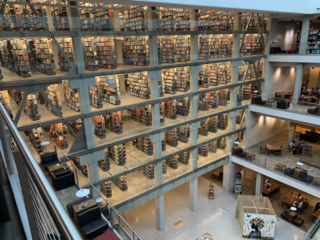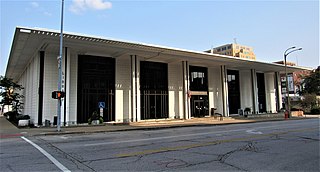Vancouver Public Library (VPL) is the public library system for the city of Vancouver, British Columbia. In 2013, VPL had more than 6.9 million visits with patrons borrowing nearly 9.5 million items including: books, ebooks, CDs, DVDs, newspapers and magazines. Across 22 locations and online, VPL serves nearly 428,000 active members and is the third-largest public library system in Canada.

North Market is a food hall and public market in Columbus, Ohio. The Downtown Columbus market was established in 1876, and was the second of four founded in Columbus. The market is managed by the non-profit North Market Development Authority (NDMA), which also manages North Market Bridge Park, a market in Dublin, Ohio.

Eaton Hall, built in 1908 as Eaton Memorial Library, used to be the main library building at Tufts University in Medford, Massachusetts. The historic building was designed by Whitfield & King and donated to the university by Andrew Carnegie. It was one of the first college libraries built with Carnegie funds and is one of the few that never bore his name. Today the building houses departmental offices, classrooms and a computer lab.

The Columbus Metropolitan Library (CML) is a public library system in Franklin County, Ohio, in the Columbus metropolitan area. The library serves an area of 872,000 residents, has a collection of 1,483,433 volumes, and circulates 17,262,267 items per year.

The William Oxley Thompson Memorial Library is the main library at Ohio State University's Columbus campus. It is the university's largest library and houses its main stacks, special collections, rare books and manuscripts, and many departmental subject libraries. The library was originally built in 1912, and was renovated in 1951, 1977, and 2009. It is named in honor of the university's fifth president, William Oxley Thompson.
The Greene County Public Library serves the communities of Greene County, Ohio. The library system's administrative offices are in Xenia, and other branches are located in Beavercreek, Cedarville, Fairborn, Jamestown, Bellbrook, and Yellow Springs. Greene County Library is a member of the Miami Valley Libraries, one of eleven regional library cooperatives in Ohio.

The Fullerton Public Library (FPL), is a public library system that serves the City of Fullerton, California and its surrounding communities.

The Stephen A. Schwarzman Building, commonly known as the Main Branch or the New York Public Library, is the flagship building in the New York Public Library system in the Midtown Manhattan neighborhood of New York City. The branch, one of four research libraries in the library system, contains nine separate divisions. The structure contains four stories open to the public. The main entrance steps are at Fifth Avenue at its intersection with East 41st Street. As of 2015, the branch contains an estimated 2.5 million volumes in its stacks. The building was declared a National Historic Landmark, a National Register of Historic Places site, and a New York City designated landmark in the 1960s.

The Ludington Public Library is one of the two branches of the Mason County District Library administrative system. This library, as the main branch, is located in downtown Ludington, in Mason County in the Lower Peninsula of Michigan. The library started as an idea that in 1872 formed an association. A trial for a free reading room was undertaken and later a small building was acquired for a definitive reading room.

The Davenport Public Library is a public library located in Davenport, Iowa. With a history dating back to 1839, the Davenport Public Library's Main Library is currently housed in a 1960s building designed by Kennedy Center architect Edward Durell Stone. The Davenport Public Library system is made up of three libraries—the Main Library at 321 Main Street; the Fairmount Branch Library at 3000 N. Fairmount Street; and the Eastern Avenue Branch Library at 6000 Eastern Avenue.

The Delaware County Courthouse is located at 117 N Union St, Delaware, OH 43015 in Delaware, Ohio. The courthouse was placed on the National Register.

Alumni Hall, formerly known as Alumni Library, is an academic building at Miami University in Oxford, Ohio. It currently houses the university's Department of Architecture and Interior Design and the Wertz Art and Architecture Library. A Lombardic Romanesque building, Alumni Hall was built in 1910 and was funded by the Carnegie Corporation of New York.

The Santa Monica Public Library (SMPL) is the public library serving residents of Santa Monica, California and surrounding areas. SMPL is directed by a City Librarian, who reports to the Santa Monica City Manager's Office and is overseen by a Library Board consisting of five members appointed by the Santa Monica City Council.

The Carnegie Public Library in East Liverpool, Ohio is a public library located at 219 East Fourth Street. The construction of the library, which opened in 1902, was funded by industrialist and philanthropist Andrew Carnegie, whose uncle lived in East Liverpool. Along with the Steubenville, Ohio library, it was the first library in Ohio funded by Carnegie. It was listed on the National Register of Historic Places in March 1980.

The Hillsdale Library is a branch of the Multnomah County Library, located in Hillsdale, Portland, Oregon. The branch offers the Multnomah County Library catalog of two million books, periodicals and other materials. The original library building at this location opened in 1957 and was replaced by a new building on the same site in 2004. The new library, a green building designed to minimize environmental impacts, has 12,000 square feet (1,100 m2) of floor space and a storage capacity of 75,000 volumes.

The Ohio History Center is a history museum and research center in Columbus, Ohio. It is the primary museum for Ohio's history, and is the headquarters, offices, and library of the Ohio History Connection. The building also houses Ohio's state archives, also managed by the Ohio History Connection. The museum is located at the Ohio State Fairgrounds, site of the Ohio State Fair, and a short distance north of downtown. The history center opened in 1970 as the Ohio Historical Center, moving the museum from its former site by the Ohio State University. The building was designed by Ireland & Associates in the Brutalist style.

The Cleo Rogers Memorial Library, also known as the Main Library, is the flagship library of the Bartholomew County Public Library system. It includes a branch in Hope, Indiana, and a bookmobile that serves the county. The building was designed by I. M. Pei & Partners and constructed by Dunlap & Company, completed in 1969, and dedicated in 1971. It is notable for its design of red brick with concrete details and its Library Plaza, an urban space punctuated by the sculpture, "Large Arch" by Henry Moore. It is named for Cleo Rogers (1905-1964) who was the county librarian for 28 years and assistant librarian for nine years.

The Easton Area Public Library serves the community of Easton in Northampton County, Pennsylvania. The present Carnegie library was predated by a community library constructed by the Easton Library Company in 1811. With a grant in 1901 for $57,000 by industrialist Andrew Carnegie a new library began construction at 515 Church Street and was completed in 1903. The library system consists of the Easton library serving as the headquarters, and the Palmer Branch located at 1 Weller Place, Palmer Township which was constructed in 1986.

The Main Library of the Columbus Metropolitan Library (CML) system is located in Downtown Columbus, Ohio, United States. The public library is the largest in the library system and holds approximately 300,000 volumes. It includes numerous rooms, including separate spaces for children, teens, an adult reading room, newspaper room, auditorium, gallery, gift shop, and a cafe. The third floor includes a computer lab and houses the Franklin County Genealogical & Historical Society.

The Thomas J. Moyer Ohio Judicial Center is a state courthouse, office building, and library in Columbus, Ohio, in the city's downtown Civic Center. The building is the headquarters of the Supreme Court of Ohio, the state's highest court, as well as the Ohio Court of Claims and Ohio Judicial Conference. The judicial center is named after the court's former chief justice Thomas J. Moyer.
























